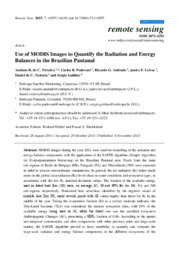Use of MODIS Images to Quantify the Radiation and Energy Balances in the Brazilian Pantanal.
Use of MODIS Images to Quantify the Radiation and Energy Balances in the Brazilian Pantanal.
Autoria: TEIXEIRA, A. H. de C.; PADOVANI, C. R.; ANDRADE, R. G.; LEIVAS, J. F.; VICTORIA, D. de C.; GALDINO, S.
Resumo: MODIS images during the year 2012 were used for modelling of the radiation and energy balance components with the application of the SAFER algorithm (Simple Algorithm for Evapotranspiration Retrieving) in the Brazilian Pantanal area. Pixels from the main sub-regions of Barão de Melgaço (BR), Paiaguás (PA) and Nhecolândia (NH) were extracted in order to process microclimatic comparisons. In general, the net radiation (Rn) relied much more on the global solar radiation (RG) levels than on water conditions and ecosystem types, in accordance with the low Rn standard deviation values. The fraction of the available energy used as latent heat flux (λE) were, on average, 65, 50 and 49% for the BR, PA and NH sub-regions, respectively. Horizontal heat advection, identified by the negative values of sensible heat flux (H), made several pixels with λE values higher than those for Rn in the middle of the year. Taking the evaporative fraction (Ef) as a surface moisture indicator, the Tree-Lined Savanna (TLS) was considered the moister ecosystem class, with 58% of the available energy being used as λE, while the driest one was the modified ecosystem Anthropogenic Changes (AC), presenting a λE/Rn fraction of 0.46. According to the spatial and temporal consistencies, and after comparisons with other previous point and large-scale studies, the SAFER algorithm proved to have sensibility to quantify and compare the large-scale radiation and energy balance components in the different ecosystems of the Brazilian Pantanal. The algorithm is useful for monitoring the energy exchange dynamics among the different terrestrial and aquatic ecosystem types throughout the seasons of the year.
Ano de publicação: 2015
Tipo de publicação: Artigo de periódico
Unidade: Embrapa Territorial
Palavras-chave: Balanço de energia, Evaporative fraction, Latent heat flux, Net radiation, Radiação térmica, Sensible heat flux
Observações
1 - Por padrão são exibidas publicações dos últimos 20 anos. Para encontrar publicações mais antigas, configure o filtro ano de publicação, colocando o ano a partir do qual você deseja encontrar publicações. O filtro está na coluna da esquerda na busca acima.
2 - Para ler algumas publicações da Embrapa (apenas as que estão em formato ePub), é necessário ter, no celular ou computador, um desses softwares gratuitos. Sistemas Android: Google Play Livros; IOS: iBooks; Windows e Linux: software Calibre.
Acesse outras publicações
Acesse a Base de Dados da Pesquisa Agropecuária (BDPA) para consultar o acervo completo das bibliotecas da Embrapa.

